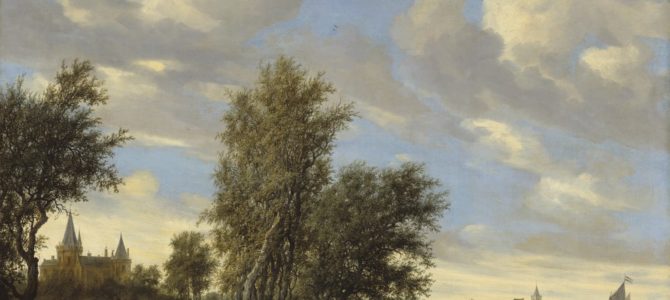
For more than two decades now, the National Gallery of Art (NGA) and the nation have benefitted from the generosity of Lee and Juliet Folger, who through the Folger Fund have helped the museum acquire some remarkable jewels of Northern European art. The NGA’s latest show, “Clouds, Ice, and Bounty: The Lee and Juliet Folger Fund Collection of Seventeenth-Century Dutch and Flemish Paintings,” brings together a number of these acquisitions, including three acquired during or just prior to the museum closing under Covid-19 lockdowns.
While the size of many of these works may surprise those who tend to think of European Baroque paintings as generally gargantuan affairs, this carefully selected grouping speaks to the concept of small not only being beautiful, but carrying greater significance than might first be apparent to 21st-century eyes.
Of course, there are some larger-scale paintings in the exhibition, including still lifes, landscapes, and seascapes. One of these is “Skating on the Frozen Amstel River” (1611) by Adam van Breen (1585-1642) who appears to be simultaneously the artistic descendent of Gothic and Renaissance painters like Pieter Bruegel and the ancestor of Modern illustrators like Mitsumasa Anno.

So much detail is crowded into this single picture that one could visually feast on it for hours. Whether admiring the view of Amsterdam in the distance, or enjoying the interactions of skating couples, young children, or those who have taken a tumble on the ice, larger works such as this can be admired both up close and from a distance.
Yet, as is suitable to the NGA’s Cabinet Galleries (now freshly repainted a pale shade of blue), the majority of the pictures in the show are more intimate in scale. Many are about the size of a sheet of letter paper, or even smaller.
These works encourage you to lean in and look closely at the details and marvel at the artists’ skills. Yet, as we will see, what these artists were doing, in many cases, may not be picked up on by a contemporary observer without a bit of guidance and reflection. Fortunately, the magnificent exhibition catalog—which has one of the most striking covers I’ve seen in a while—is a terrific accompaniment to the show in this regard.
The Wonders of Small
The work of Clara Peeters (c.1594-1640), for example, such as “Still Life with Flowers Surrounded by Insects and a Snail” (c. 1610), is small scale indeed: in this case, roughly the size of a 5-inch by 7-inch photograph.
Only about 40 paintings by Peeters are known to exist. This early work, an oil on copper painted when she was about just 16 years old, gives little hint of the somewhat larger, more complex still lifes involving food, luxury tableware, and even cats that she would come to be known for as she matured.

If this image were simply a depiction of spring flowers in a bulbous glass vase against a dark background, it would be enough to delight the eye. Peeters takes things one step further, however, and adds a white, oval border covered with insects and a colorful snail, all arranged to appear as though they are looking beyond the edge of the border at the floral arrangement within.
Equally eye-catching is a related work on loan to the exhibition from the Folgers’ private collection. “Dragonfly, Butterfly, and Other Insects, with Auricula, Morning Glory, and Shells” (c. 1655) by Jan van Kessel the Elder (1626-1679) is, like the Peeters picture, a small oil painting on copper. Yet while the creepy-crawlies in Peeters’s painting are depicted on the outside looking in at another image, in van Kessel’s painting not only is there no separation between the animate and inanimate, but the living things appear to be interacting peacefully while near the inanimate objects.
Set against a plain, white background, van Kessel’s scientific precision and rich colors draw us in for a closer look, such as in the blue rim of the morning glories echoed in the large blue eyes and long thorax of the dragonfly.
One can certainly appreciate and enjoy these pictures for their own sake. Yet it’s also entirely possible that both Peeters and van Kessel are inviting us to consider the notion of a “peaceable kingdom” as described in Chapter 11 of Isaiah, in which the advent of the Messiah brings about peace among men and indeed all of creation, “for the earth shall be full of the knowledge of the Lord, as the waters cover the sea.”
What the Uncaged Bird Sings
Just as these arrangements may have been designed to provide an element of meaning to the 17th-century viewer contemplating them in a home setting, small-scale portraits also often had a story to tell about the sitter beyond what a contemporary viewer of today might pick up on.
In his charming “A Woman Feeding a Parrot with a Page” (1666), which is only about 14 by 18 inches in size, Dutch artist Caspar Netscher (1639-1684) gives us plenty of luxurious textiles to gawk at, a painterly talent for which his work has always been highly prized. The heavy carpet and curtain spilling out through the stone arch that frames the scene speak of a taste for imported finery, and a fondness for the ostentatious display of wealth. It would be easy to assume that this is simply the image of a pretty, fashionably dressed young lady from a well-to-do background, with the means to have silk dresses, servants, and exotic pets.

As noted by Kristen Gonzalez of the NGA’s Department of Northern European Paintings in a 2017 essay on parrots in Dutch art of this period, however, owning one of these birds in 17th century Holland was not simply a sign of affluence, although importing them from warmer climates was likely very expensive. It also spoke to the sophistication, education, and scientific curiosity of the owner.
While a caged bird was viewed as symbolic of fidelity and chastity, the depiction of an uncaged bird with an empty cage nearby could be seen as suggestive of someone being on the loose, as it were. Since the African Gray Parrot was considered to be the most intelligent member of the parrot family, we might reasonably conclude that its presence in this portrait is intended to tell us something about the character and personality of the subject. The fact that the parrot is no longer in its cage, and is out on display, may tell us something else about her as well.
That’s One Big Asparagus
Not all the pictures in this show have to be seen through a particular lens to be appreciated. I particularly relished, if you’ll pardon the term, a “Still Life with Asparagus and Red Currants” (1696) by Adriaen Coorte (c. 1683-1707). Even without considering all the possible meanings intended by the asparagus and currants, ranging from evocations of prosperity, romance, slumber, or even the Garden of Eden, this picture’s stark beauty transcends the era in which it was painted. The artist seems to have been particularly fond of asparagus, for he is known to have painted it numerous times.

What’s more, Coorte doesn’t just paint a bunch of your standard, garden-variety skinny green spears that go on the side of your plate next to your steak, but big, fat, succulent white asparagus, the sort one would ask for when eating outdoors in springtime in a tavern in Madrid, with just a bit of lemon juice and mayonnaise for accompaniment. In fact, such depictions of beautifully painted fruits and vegetables against a dark background with no adornments were hugely popular in Spain during the same period, where they were known as “bodegónes,” meaning one could easily be forgiven for thinking that this was a Spanish Golden Age piece.
Whether you choose to dig deeper into the meaning behind many of the paintings in this show, or just want to enjoy them as beautiful works of art, this is an exhibition with a bit of something for any art aficionado, from naval scenes and religious pictures to barking dogs and spouting narwhals. Short of visiting the Low Countries, it would be difficult to find a more diverse and interesting show of smaller-scale art dating from an important time and place in art history. Like the Low Countries, these works punch well above their weight, and we should all be grateful to the Folger family for helping to bring them to us.
“Clouds, Ice, and Bounty: The Lee and Juliet Folger Fund Collection of Seventeenth-Century Dutch and Flemish Paintings” is at the National Gallery of Art until February 27. If you can’t make it in person to the exhibition, be sure to check out the National Gallery’s website for videos, podcasts, and educational materials related to the show.









